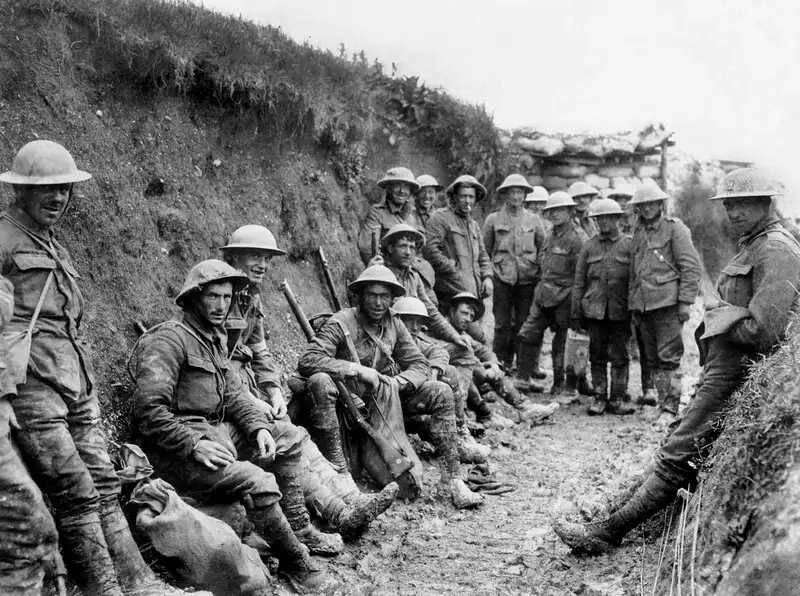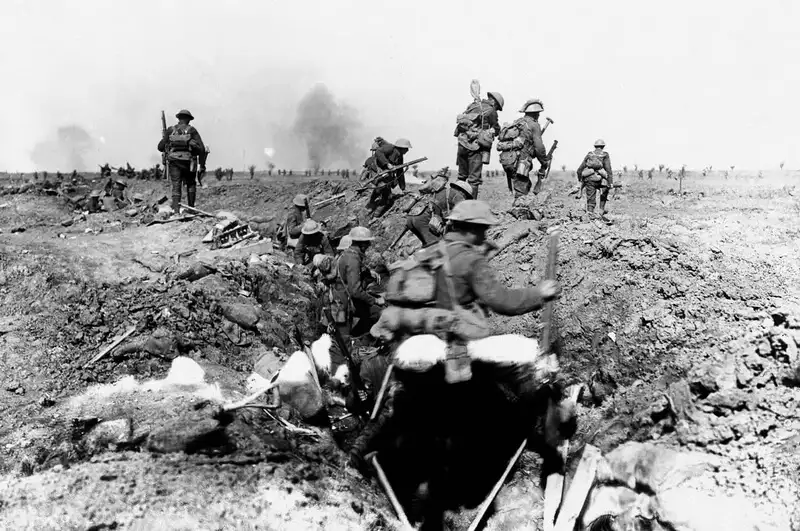The Battle of the Somme, fought from July to November 1916, began as an Allied offensive against German forces along the Western Front in World War I, near the Somme River in France. It became one of the bitterest, bloodiest, and costliest battles in human history, with the British suffering over 57,000 casualties—more than 19,000 of whom died—on the first day alone.
By the time the Battle of the Somme concluded nearly five months later, over 3 million soldiers from both sides had engaged in combat, and more than 1 million were killed or wounded. In this article, Pywar will share why the Somme is remembered as the fiercest battle of its time.
The Battle Begins – July 1, 1916
Before the assault, the Allies conducted a week-long, intense artillery bombardment, firing approximately 1.75 million shells to cut through the barbed wire protecting German trench defenses and destroy enemy positions.
On the morning of July 1, 11 divisions of the British Fourth Army—many of them first-time volunteer soldiers—launched an attack across a 15-mile front north of the Somme River. Simultaneously, five French divisions advanced along an 8-mile front to the south, where German defenses were weaker.
Allied leaders were confident that the bombardment would devastate German lines enough for their troops to advance easily. However, the barbed wire remained intact in many areas, and German positions—many shielded by deep underground trenches—proved far more resilient than anticipated.
Along the front, German machine-gun and rifle fire mowed down thousands of advancing British soldiers, many of whom became trapped in the “no man’s land” between the opposing lines.
By the end of the first day, approximately 19,240 British soldiers had been killed and over 38,000 wounded—a casualty toll nearly equivalent to what the British endured during the Allied defeat in France in World War II (May–June 1940), including prisoners.

A War of Attrition
Other British and French forces achieved limited success in the south, though these gains were minor compared to the catastrophic losses suffered on the first day.
Nevertheless, British Field Marshal Douglas Haig remained determined to press the offensive. Over the next two weeks, British troops launched a series of smaller attacks on German lines, applying increasing pressure and forcing the Germans to divert weapons and troops from the Battle of Verdun.
In the early morning of July 15, the British conducted another artillery barrage, followed by a major assault targeting Bazentin Ridge, north of the Somme. The attack caught the Germans off guard, allowing the British to advance about 6,000 yards into enemy territory and capture the village of Longueval.
However, every small advance in this prolonged and deadly war of attrition came at a steep cost. By the end of July, the Germans had lost 160,000 soldiers, while British and French forces suffered over 200,000 casualties.
By late August, as German morale waned due to territorial losses at both the Somme and Verdun, German Commander-in-Chief Erich von Falkenhayn was replaced by Paul von Hindenburg and Erich Ludendorff. This leadership change also marked a strategic shift for Germany: they began constructing a new defensive line behind the Somme front, conceding territory but aiming to inflict further casualties on the advancing Allies.

Tanks Enter the Battle
On September 15, during an attack at Flers-Courcelette, British artillery bombardment was followed by 12 infantry divisions advancing alongside 48 Mark I tanks—the first time tanks appeared on a battlefield.
However, these early tanks were still in development, and many broke down before reaching the front lines. Though the British advanced about 1.5 miles, they suffered approximately 29,000 casualties and failed to achieve a decisive breakthrough.
As October began, worsening weather hampered another Allied offensive, with soldiers struggling through muddy terrain while enduring fierce German artillery and fighter plane attacks. The Allies launched their final assault of the battle in mid-November, targeting German positions in the Ancre River valley.
With the onset of harsh winter weather, Haig finally ordered a halt to the offensive on November 18, ending the bloody Battle of the Somme—at least until the following year. Over 141 days, the British advanced just seven miles and failed to break the German lines.

Aftermath of the Somme
The Battle of the Somme—particularly its catastrophic first day—is remembered as a symbol of the brutality and seemingly senseless slaughter characteristic of trench warfare in World War I. British officers, especially Haig, faced criticism for continuing the offensive despite staggering losses.
Many British soldiers at the Somme were volunteers who enlisted in 1914 and 1915, experiencing combat for the first time. A significant number belonged to “Pals battalions,” units composed of friends, relatives, and neighbors from the same communities.
A heartbreaking example of a community’s loss occurred on July 1 at the Somme, when approximately 720 soldiers from the 11th East Lancashire Battalion (known as the Accrington Pals) entered combat; 584 of them were killed or wounded.
Who Won the Battle of the Somme?
The Allied victory at the Somme, though dearly bought, inflicted severe damage on German positions in France, forcing a strategic German retreat to the Hindenburg Line in March 1917 rather than continuing to fight on the same ground that spring.
While exact figures remain debated, German losses by the end of the Somme may have exceeded those of the British, with around 450,000 German soldiers compared to 420,000 British. However, the surviving Allied forces gained valuable experience that later contributed to their ultimate victory on the Western Front.
Conclusion
The Battle of the Somme stands as an emblem of World War I’s brutality, with immense losses but strategic gains for the Allies. Despite advancing just seven miles and suffering over 1 million casualties, the battle compelled a German strategic withdrawal and provided the Allies with critical experience. Pywar hopes this article has offered a comprehensive overview of this historic battle. Be sure to explore more articles on world war history and the latest news!
Translated by: Le Tuan
Source: History.com – Battle of the Somme



